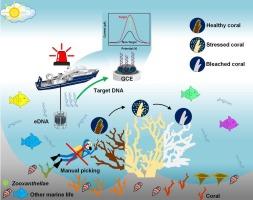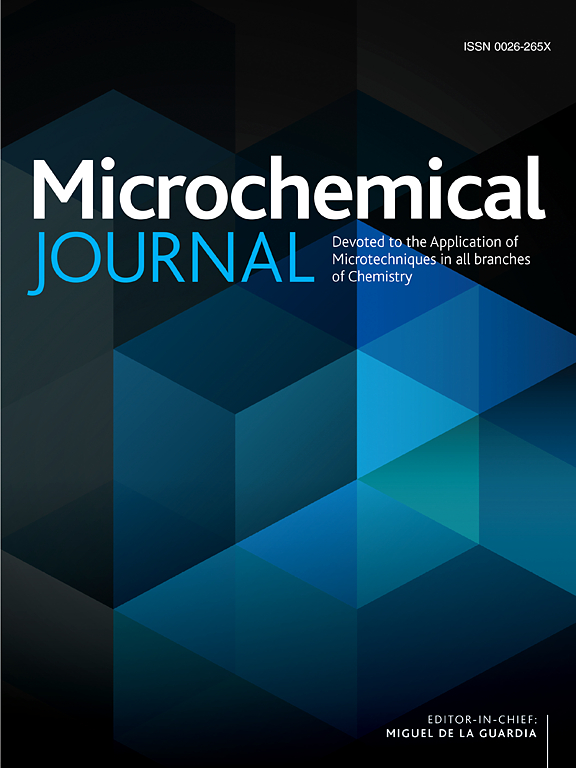An advanced early warning technology for coral bleaching crisis based on the electrochemical biosensing of coral-symbiotic zooxanthellae eDNA
IF 4.9
2区 化学
Q1 CHEMISTRY, ANALYTICAL
引用次数: 0
Abstract
The symbiotic zooxanthellae in corals are extremely sensitive to the marine environment, and corals bleach rapidly when the symbiotic zooxanthellae are detached from their coral hosts. Currently, ecological monitoring techniques face many problems in coral health assessment, especially coral reef destruction during sampling. In this paper, an electrochemical eDNA biosensor based on ECM/MoS2 nanocomposites constructed with specific DNA probes was developed to detect the environmental DNA of free zooxanthellae at a low limit of detection (LOD = 0.223 pM) and limit of quantification (LOQ = 0.743 pM) under the experimentally optimized conditions, demonstrating excellent specificity and steadiness. Over and above, the electrochemical response of the biosensor to zooxanthellae DNA was significantly higher than that of other interferent targets, proving its high selectivity. On this basis, the dependability and precision of the biosensor were further verified by comparing the biosensor with ddPCR (P > 0.05, RSD < 5 %). Hence, this electrochemical biosensor can dynamically monitor community changes in zooxanthellae without destroying coral reefs and may serve as a non-invasive method for early warning of coral reef crises. The technique can also be upgraded with portable capabilities in future studies to provide greater convenience in the field analysis of coral bleaching.

基于珊瑚-共生贝藻 eDNA 电化学生物传感的珊瑚白化危机高级预警技术
珊瑚中的共生动物贝对海洋环境极为敏感,当共生动物贝脱离珊瑚宿主时,珊瑚会迅速漂白。目前,生态监测技术在珊瑚健康评估中面临诸多问题,尤其是采样过程中对珊瑚礁的破坏。本文基于 ECM/MoS2 纳米复合材料与特异性 DNA 探针构建了一种电化学 eDNA 生物传感器,在实验优化的条件下,以较低的检出限(LOD = 0.223 pM)和定量限(LOQ = 0.743 pM)检测环境中游离的动物贝类 DNA,表现出良好的特异性和稳定性。此外,该生物传感器对动物贝类 DNA 的电化学响应明显高于其他干扰目标,证明了其高选择性。在此基础上,生物传感器与 ddPCR 的比较进一步验证了生物传感器的可靠性和精确性(P > 0.05, RSD < 5 %)。因此,这种电化学生物传感器可以在不破坏珊瑚礁的情况下动态监测动物贝类群落的变化,可作为珊瑚礁危机预警的非侵入性方法。在未来的研究中,该技术还可以升级为便携式,为珊瑚白化的实地分析提供更大的便利。
本文章由计算机程序翻译,如有差异,请以英文原文为准。
求助全文
约1分钟内获得全文
求助全文
来源期刊

Microchemical Journal
化学-分析化学
CiteScore
8.70
自引率
8.30%
发文量
1131
审稿时长
1.9 months
期刊介绍:
The Microchemical Journal is a peer reviewed journal devoted to all aspects and phases of analytical chemistry and chemical analysis. The Microchemical Journal publishes articles which are at the forefront of modern analytical chemistry and cover innovations in the techniques to the finest possible limits. This includes fundamental aspects, instrumentation, new developments, innovative and novel methods and applications including environmental and clinical field.
Traditional classical analytical methods such as spectrophotometry and titrimetry as well as established instrumentation methods such as flame and graphite furnace atomic absorption spectrometry, gas chromatography, and modified glassy or carbon electrode electrochemical methods will be considered, provided they show significant improvements and novelty compared to the established methods.
 求助内容:
求助内容: 应助结果提醒方式:
应助结果提醒方式:


